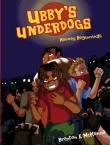 5681546241000789155.jpg
5681546241000789155.jpg
 5681546241000789155.jpg
5681546241000789155.jpg
'It is the late 1940s and Broome, a small pearling town in the heart of an ancient land, is still recovering from WWII. Ubby, a smart, street-wise Aboriginal girl, is the leader of a small rag-tag gang known as the ‘Underdogs.’ Ubby’s Underdogs: Heroes Beginnings (Book 2) is storytelling on a remarkable scale. It continues with established characters that have links to other worlds amidst an intricate backdrop of Aboriginal and Chinese mythology. In this second graphic novel of the Ubby’s Trilogy, efforts to locate Sai Fong, the Dragon Summoner, by Ubby and her gang have been halted by the ambitious Pearling Master, Paul Donappleton. Yupman, the guardian of Sai Fong, is pushed to breaking point as his past reaches out to strike and his greatest fear now sits upon the horizon.' (Publisher's blurb)
Unit Suitable For AC: Year 7 (NSW Stage 4)
Duration Six weeks
Themes
Aboriginal history and culture, bravery, Chinese history, corruption, Day of the Girl, feminism, friendship, good and evil, heroes and villains, heroism, inter-cultural relationships, magic, magic realism, morality, Myths and Legends, power and authority, racism, relationships, sexism, teenage gangs, violence
Cross-curriculum Priorities
Aboriginal and Torres Strait Islander histories and cultures, Asia and Australia's engagement with Asia
"The ‘Ubby’s Underdogs’ books are the first graphic novels published by Magabala Books,representing an innovation which maintains the inventiveness characteristic of Magabala’s picture books. The trilogy’s treatment of the Underdogs’ exploits in multicultural Broome foregrounds the encounter between Aboriginal and Chinese cultural traditions. By drawing on a blend of cultural signifiers, the novels display the carnivalesque qualities described by Mikhail Bakhtin in Rabelais and His World (1984). In McKenna’s novels carnivalesque scenes, polyglot voices and intercultural dialogues give rise to a transformative vision of a community which resists monologic authoritarianism. Like graphic novels more generally, the Underdogs novels rely on visual, verbal and cultural stereotypes to enable rapid identification of characters of various ethnicities. They transform such stereotypical and exoticised figures through modes of representation and narrative which privilege the ‘culture of folk carnival humour’ (Bakhtin 1984, p. 4) to present negotiations between and across cultures in the setting of post-war Broome." (Introduction)
"The ‘Ubby’s Underdogs’ books are the first graphic novels published by Magabala Books,representing an innovation which maintains the inventiveness characteristic of Magabala’s picture books. The trilogy’s treatment of the Underdogs’ exploits in multicultural Broome foregrounds the encounter between Aboriginal and Chinese cultural traditions. By drawing on a blend of cultural signifiers, the novels display the carnivalesque qualities described by Mikhail Bakhtin in Rabelais and His World (1984). In McKenna’s novels carnivalesque scenes, polyglot voices and intercultural dialogues give rise to a transformative vision of a community which resists monologic authoritarianism. Like graphic novels more generally, the Underdogs novels rely on visual, verbal and cultural stereotypes to enable rapid identification of characters of various ethnicities. They transform such stereotypical and exoticised figures through modes of representation and narrative which privilege the ‘culture of folk carnival humour’ (Bakhtin 1984, p. 4) to present negotiations between and across cultures in the setting of post-war Broome." (Introduction)